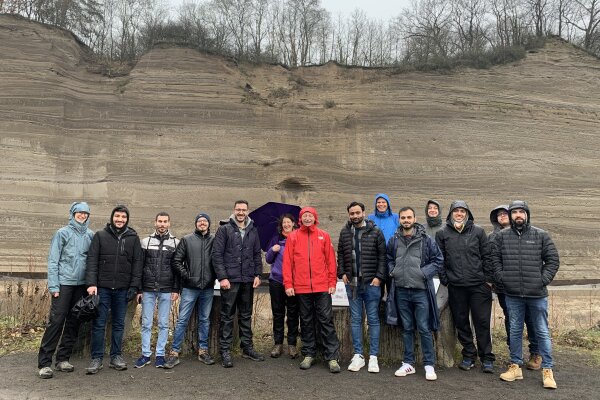31.03.2023

To conclude their very first semester the Subsurface Engineering students went on a field trip in the Eifel region. As part of a compulsory module, such excursions are an integral part of the SubSurf curriculum. The Eifel is a low mountain range in North Rhine-Westphalia and Rhineland-Palatinate. It extends further into Belgium and Luxembourg in the Ardennes. Geologically, the region is best known for its volcanism and how it shaped the landscape.
The excursion led to the “Bausenberg”, where a volcanic eruption occurred thousands of years ago. The main objective of the field camp was to explore the location, orientation, depth, and properties of the once molten lava, such as conductivity, using different methods like geoelectrics, geomagnetics, ground penetration radar, and hammer seismic.
Although not without the supervision of Prof. Friederich and his Team, the students were responsible for conducting the experiments themselves, which gave them a real sense of engineering. Thus, they had the opportunity to merge the theoretical and practical aspects of their studies during the excursion.
Overall, the excursion was a fantastic opportunity for the students to deepen their understanding of geology, develop their skills, and gain valuable experience in the field. The students returned home with a newfound appreciation for the practical applications of their studies and a greater understanding of the geological processes that shape our world. For further excursions, the students only hope for better weather.
To conclude their very first semester the Subsurface Engineering students went on a field trip in the Eifel region. As part of a compulsory module, such excursions are an integral part of the SubSurf curriculum. The Eifel is a low mountain range in North Rhine-Westphalia and Rhineland-Palatinate. It extends further into Belgium and Luxembourg in the Ardennes. Geologically, the region is best known for its volcanism and how it shaped the landscape.
The excursion led to the “Bausenberg”, where a volcanic eruption occurred thousands of years ago. The main objective of the field camp was to explore the location, orientation, depth, and properties of the once molten lava, such as conductivity, using different methods like geoelectrics, geomagnetics, ground penetration radar, and hammer seismic.
Although not without the supervision of Prof. Friederich and his Team, the students were responsible for conducting the experiments themselves, which gave them a real sense of engineering. Thus, they had the opportunity to merge the theoretical and practical aspects of their studies during the excursion.
Overall, the excursion was a fantastic opportunity for the students to deepen their understanding of geology, develop their skills, and gain valuable experience in the field. The students returned home with a newfound appreciation for the practical applications of their studies and a greater understanding of the geological processes that shape our world. For further excursions, the students only hope for better weather.